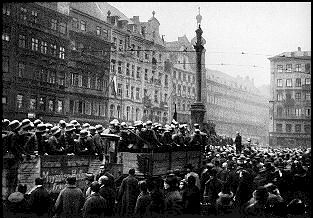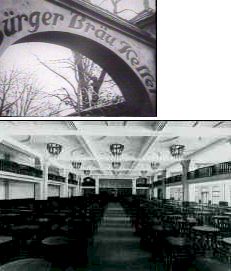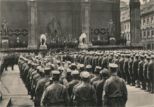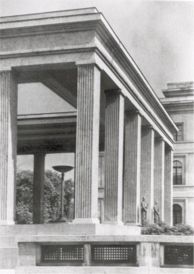
To order Hitler Sites ($55) click here
Hitler and cronies' annual re-enactment of Beerhall Putsch march,
November 1938:
Launch Real Player
This option requires Real Player.
Click
here to download Real Player
Launch
Windows Media Player
This option requires Microsoft's Windows Media Player.
Click
here to download Windows Media Player
 During the November 1923 Beer Hall Putsch, Hitler tried but
failed to take control of the conservative Bavarian state government and the
Weimar government in Berlin. He was already head of the National Socialist
German Workers’ Party, with 70,000 members the most powerful political party in
Bavaria. He and many other Germans viewed the freely elected government of the
Weimar Republic as an abomination that the victorious Allies had imposed after
the German defeat in World War I. Moreover, Germany was in the throes of
catastrophic hyperinflation, and French troops had just occupied the Ruhr.
Hitler wrongly believed that the social upheaval these two calamities were
causing would assure success for the putschists.
During the November 1923 Beer Hall Putsch, Hitler tried but
failed to take control of the conservative Bavarian state government and the
Weimar government in Berlin. He was already head of the National Socialist
German Workers’ Party, with 70,000 members the most powerful political party in
Bavaria. He and many other Germans viewed the freely elected government of the
Weimar Republic as an abomination that the victorious Allies had imposed after
the German defeat in World War I. Moreover, Germany was in the throes of
catastrophic hyperinflation, and French troops had just occupied the Ruhr.
Hitler wrongly believed that the social upheaval these two calamities were
causing would assure success for the putschists.
The Bavarian government’s leaders were scornful of the Berlin government, and
were themselves plotting the formation of a new nationalist dictatorship in
Berlin. Three men controlled the government of Bavaria: Otto von Lossow, head of
the Bavarian army; Gustav Ritter von Kahr, General State Commissar; and Hans
Ritter von Seisser, the Bavarian police chief. These men sympathized with many
of Hitler’s views but did not like some of his radical ideas.
 On the evening of November 8, 1923, the Putsch began at the Bürgerbräukeller,
where a large group of prominent Bavarians had gathered, among them Kahr,
Lossow, and Seisser, as well as Hitler and Erich Ludendorff. The former army
general quartermaster, Ludendorff was the man who was mainly responsible for
Germany's military policy and strategy in the latter years of World War I.
On the evening of November 8, 1923, the Putsch began at the Bürgerbräukeller,
where a large group of prominent Bavarians had gathered, among them Kahr,
Lossow, and Seisser, as well as Hitler and Erich Ludendorff. The former army
general quartermaster, Ludendorff was the man who was mainly responsible for
Germany's military policy and strategy in the latter years of World War I.
For half an hour, Kahr had been reading a prepared speech to the crowd of 3,000
packed into the Burgerbräukeller, when Hitler made his grand entrance. A clutch
of men in steel helmets, Hitler’s storm troopers, appeared, and pushed in a
heavy machine gun. Hitler materialized, accompanied by two armed bodyguards
brandishing pistols. Hitler stood on a chair, and, drowned out by the tumult, he
pulled out his Browning automatic pistol and fired a shot through the ceiling.
Hitler announced that the revolution had broken out and six hundred armed men
surrounded the hall. The Bavarian government was deposed, he shouted, and he
would form a provisional Reich government. He requested Kahr, Lossow, and
Seisser to follow him into an adjoining room. Reluctantly they complied.
Pandemonium reigned, but Hermann Göring, a former World War I flying ace and
Hitler’s ally, urged everyone to be calm. “You’ve got your beer,” he said
(Kershaw, 1998).
Waving his pistol in the next room, Hitler shouted that no one would leave
without his permission. He proclaimed the formation of a new government, himself
at the head. Ludendorff, Lossow, Seisser, and Kahr all agreed to be important
members. If things did not work out, Hitler declared that he had bullets in his
pistol for his collaborators and himself.
Things definitely did not work out. Lossow, Seisser, and Kahr, tepid
revolutionaries from the outset, left the hall and proceeded to inform state
authorities that they repudiated the putsch.
Meanwhile, Ernst Röhm led another group of Hitler loyalists in the
Löwenbräukeller across town. Röhm managed to capture the Bavarian War Ministry
but bungled by not taking over the telephone switchboard. Lossow was thus able
to bring loyalist forces to Munich from nearby towns. Army troops and state
police were soon besieging Röhm and his followers.
The next morning, a bitterly cold one, with the putsch rapidly crumbling, Hitler
and Ludendorff decided on a demonstration march to Röhm’s rescue through the
city. Hitler believed that a march would engender overwhelming support.
Ludendorff thought that the army would never fire at him, a revered military
leader, and that if he were in the front ranks, the soldiers would back down.
The march began at noon. A cordon of men carrying banners preceded Hitler,
Ludendorff, Göring, and Max Erwin von Scheubner-Richter, another party leader.
At the Ludwigsbrücke, the putschists confronted and overwhelmed a small group of
policemen. Throngs of shouting, waving supporters greeted the marchers on
Zweibrückenstrasse.
 From the Marienplatz, the marchers turned right into Weinstrasse, right again to
Perusastrase, left into Residenzstrasse, and in a few minutes arrived at the
Feldherrnhalle. Here the police had established a line blocking Residenzstrasse,
and there were more police on the Odeonsplatz. A putschist fired a shot, the
police hesitated, then fired back, more shooting occurred, and the putschists
and the crowd of onlookers scattered in all directions. Fourteen putschists and
four policemen died. Hitler was wrenched to the ground, and suffered a
dislocated shoulder. A bullet killed Scheubner-Richter. Göring was shot in the
leg.
From the Marienplatz, the marchers turned right into Weinstrasse, right again to
Perusastrase, left into Residenzstrasse, and in a few minutes arrived at the
Feldherrnhalle. Here the police had established a line blocking Residenzstrasse,
and there were more police on the Odeonsplatz. A putschist fired a shot, the
police hesitated, then fired back, more shooting occurred, and the putschists
and the crowd of onlookers scattered in all directions. Fourteen putschists and
four policemen died. Hitler was wrenched to the ground, and suffered a
dislocated shoulder. A bullet killed Scheubner-Richter. Göring was shot in the
leg.
Ludendorff, who had an iron nerve under fire, emerged unscathed. Oblivious to
the bullets whizzing past his head, he marched straight into the arms of waiting
police and was immediately taken into custody.
 When he came to power, Hitler built a Temple of Honor, with iron sarcophagi on
stone pedestals for the “martyrs” of the Putsch. He told Albert Speer
that he wanted his own sarcophagus here. Every November, Hitler and his cronies
re-enacted the abortive 1923 march, pausing to contemplate the inscription at
the Feldherrnhalle honoring the fallen: Und ihr habt doch gesiegt -- And
you were still victorious. (Note the use of the familiar form of address, rather
than the polite Und Sie haben doch gesiegt. Hitler almost never employed
the familiar form in ordinary conversation with his minions.)
When he came to power, Hitler built a Temple of Honor, with iron sarcophagi on
stone pedestals for the “martyrs” of the Putsch. He told Albert Speer
that he wanted his own sarcophagus here. Every November, Hitler and his cronies
re-enacted the abortive 1923 march, pausing to contemplate the inscription at
the Feldherrnhalle honoring the fallen: Und ihr habt doch gesiegt -- And
you were still victorious. (Note the use of the familiar form of address, rather
than the polite Und Sie haben doch gesiegt. Hitler almost never employed
the familiar form in ordinary conversation with his minions.)
The victorious Allies dynamited The Temple of Honor in 1947, destroyed the
sarcophagi, and discarded the putschists’ corpses. But the stone pedestals
remain. Sometimes Nazi veterans gather around them. Historic preservation
officials want to save them as “thought-stones of history.”
![]()
Changing of guard at Temple of Honor, sarcophagi of fallen
putschistists (1938):
Launch Real Player
Launch
Windows Media Player

